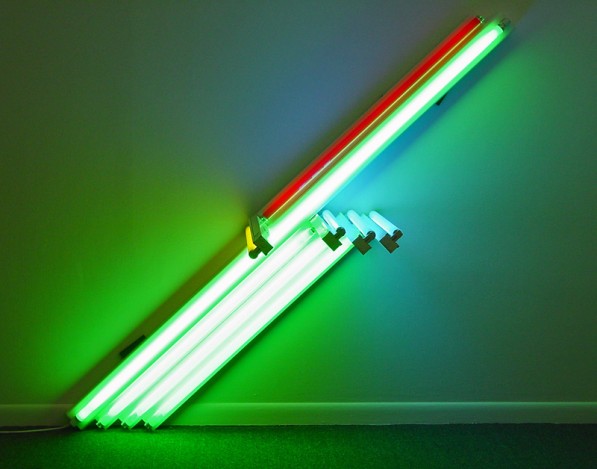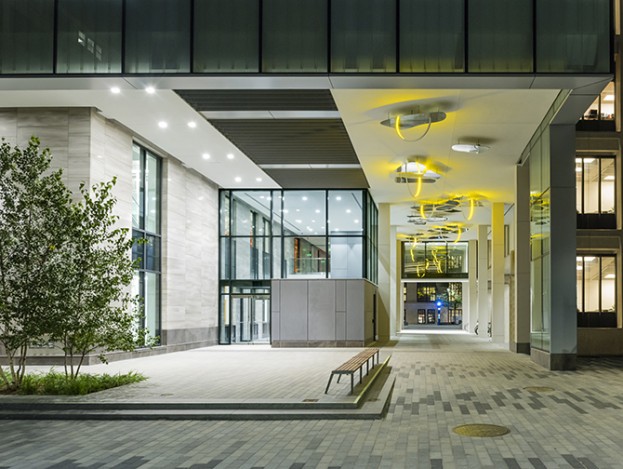This week’s contributing author, Bianca Rabbie, is a fourth year undergraduate student at Northeastern University in Boston Massachusetts pursuing a BS in Architecture.
VoCA is pleased to present this blog post in conjunction with Associate Professor of Contemporary Art History, Gloria Sutton’s Spring 2019 Honors seminar, The Art of Visual Intelligence at Northeastern University. This interdisciplinary course combines the powers of observation (formal description, visual data) with techniques of interpretation to sharpen perceptual awareness allowing students to develop compelling analysis of visual phenomena.
As the individual who takes care of the public art collection of MIT, Yuri Stone, Assistant Curator at the MIT List Visual Arts Center, is in a unique position. Unlike with an ordinary gallery exhibition, the art work Stone cares for is open to everyone and right in front of you; you may even view it when you don’t expect it or pay attention it. It reflects the community that surrounds it, and provides an intersection between disciplines and ideas coming to a point in a piece of art. If done well, public art can engage people in conversation. It creates a curiosity about what the piece might be, transforms the places we inhabit, and changes the nature of our public spaces. For this reason, the preservation and continuation of public artworks is largely important. I recently had the opportunity to speak with Stone, and was intrigued by what he had to say.
What does preservation of public artworks look like?
MIT goes to incredible lengths — and elaborate contract negotiations — to make sure that what they are investing in is going to last forever and that it is going to be the case that the wall will crumble before the artwork does. The biggest challenges in the preservation of these artworks are specifically artworks that were made in the 70s or 80s. For instance, we have a Dan Flavin piece on campus [Untitled 5c, located in the Ashdown House stairwell lobby] which has fluorescent tubes. The manufacturer was specked out when MIT acquired the piece, and at this point the manufacturer doesn’t exist anymore. So what we have to do is track down the fluorescent tubes that have very specific colors, and a very specific scale. We have to work with his estate to find the one that matches our very specific piece and that’s more of the challenge.

© 2018 Stephen Flavin / Artists Rights Society (ARS), New York
Is there an aspect of the curatorial process that you find is significantly more difficult when being involved with public works versus exhibition work?
With public art it’s a much longer timeline, you are collaborating across disciplines. When I’m working on a public art project I am usually collaborating with the general contractor of a construction company, and the facilities of the building that the artwork is going in or near. I’m also working with MIT’s general counsel to flesh out all the details of the contracts and of course I’m working with the artists, but more often with the artists fabricator or their studio.
What do you believe is the way that public art should engage the public? How do you attract human interaction and what makes that interaction valuable?
If we are referring to work that is outdoors, work that isn’t housed in a building, I think it would be hard to say that there is work that doesn’t engage the public. Some artworks lend themselves in terms of their material more than others, meaning that something like Anish Kapoor’s Cloud Gate1 in Downtown Chicago, at Millennium Park, is a very reflective material and inevitably that is going to drive visitors to interact with it. 1 You look for yourself in this thing and you become implicated in it, and the skyline is implicated as well so that you see the architecture of the city standing behind you. In comparison, Olafur Eliasson’s piece Northwest Passage here in Cambridge is able to translate his standard exhibition experience in a public, outdoor space.2 While easy to pass by and not notice, it has the capacity to pull your eye up, tricking you into seeing yourself but giving you the opportunity to engage. Once you look up you realize the detail you maybe question how it works. Once you’ve figured out how it works maybe you shift your focus into the mirrors and you see yourself, you see the ground, you slowly look around within the mirrors.

An MIT Percent-for-Art Commission for MIT.nano. Photo: Anton Grassl
Looking at both of these pieces as mechanisms to understand aspects of our world, they provide an opportunity for conversation to be had, and for it to keep being had as they are permanent pieces of our communities. The most difficult aspect in provoking these conversations is the signage involved, although it exists it is sometimes in such places that viewers won’t see it, or it isn’t in plain view as you pass by an art work. Making sure these are in the right places is key to sparking these conversations and making the art that much more impactful. But sometimes even without signage, art work still maintains the ability to have impact, when we pass by it we can make it what we want it to be. I’ve even experienced public art in which I can appropriate its purpose for what fits me best as it invited my interaction in any form.
People get excited about the work for their own reasons: both require you to see your reflection but put you in different contexts to do so. Enabling them to stand the test of time allows the conversation to continue, inherently placing great importance on their conservation and the time it takes to make sure these pieces are successful in their implementation.
[1] Cloud Gate, also known as “the Bean,” is a highly polished, mirror-like, seamless sculpture located in downtown Chicago’s Millennium Park. Warping the reflections of the city, of the people, and everything in between, it has become a site for photos, and creates conversation from its size and location as one can see themselves from many perspectives. For more information, go to https://millenniumparkfoundation.org/art-architecture/cloud-gate/
[2] Northwest Passage lies above you as you traverse through the breezeway of Building 12 at MIT. It touches on the widely discussed topic of climate change and how ice coverage used to be an impassible place, but due to melting there is ease of passage and it will get even easier with time. To learn more about this artwork, visit https://listart.mit.edu/public-art-map/northwest-passage
